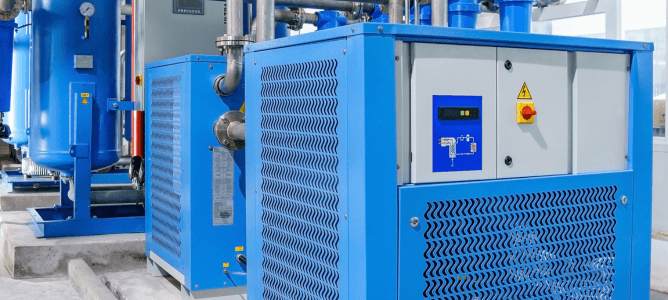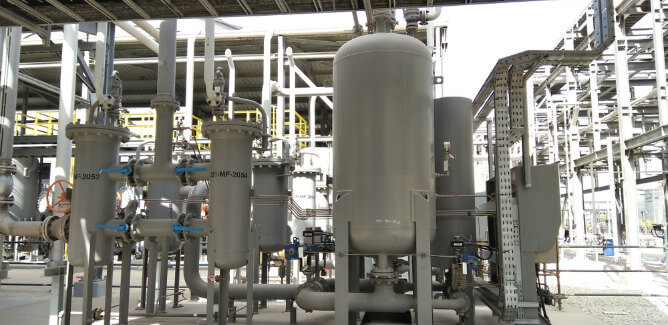
What is a Refrigerated Compressed Air Dryer?
Compressed air is a vital utility in various industries, serving as a power source for tools, equipment, and processes. However, the air generated by compressors contains moisture in the form of water vapor.
If left untreated, this moisture can cause damage to pneumatic equipment, affect product quality, and lead to costly downtime. To address this issue, refrigerated compressed air dryers (the most common type of compressed air dryer) have become crucial to many operations.
Refrigerated Compressed Air Dryers: The Basics
Refrigerant dryers are essential in many manufacturing and service applications to remove moisture from compressed air systems and prevent equipment damage due to corrosion and other issues.
Refrigerated air dryers work by lowering the air temperature to around 3°C or 35°F. When the air reaches this temperature (the dew point), the moisture in the air condenses and is then removed through drainage.
There are two types of refrigerated compressed air dryers: cycling and non-cycling.
- Cycling dryers turn the refrigeration compressor on and off based on the demand for compressed air, making them energy-efficient for applications with varying air demand.
- Non-cycling dryers continuously run the refrigeration compressor, regardless of the air demand, providing a constant dew point but consuming more energy than cycling dryers.
Refrigerated Air Dryer Components
Refrigerated air dryer systems consist of a few essential components, including:
- Heat Exchanger – The heat exchanger is responsible for cooling the incoming warm, moisture-laden air. It uses a refrigeration cycle to chill the air, lowering its temperature and causing the moisture to condense.
- Air-to-Air Heat Exchanger – After the air has been cooled, it passes through an air-to-air heat exchanger. Here, it is reheated using outgoing cold, dry air. This process helps to reduce temperature swings and prevent condensation from forming on the outside of the dryer.
- Moisture Separator – The condensed moisture needs to be separated from the compressed air. The moisture separator efficiently collects and removes this liquid, ensuring only dry air continues into the distribution system.
- Refrigeration Compressor – The refrigeration compressor is the heart of the dryer — it’s responsible for cycling refrigerant through the system to maintain the desired temperature.
Applications of Refrigerated Compressed Air Dryers

Refrigerant compressed air dryers find applications in various industries, including:
1. Manufacturing
In manufacturing processes, dry compressed air is crucial for preventing moisture-related defects in products and ensuring consistent, high-quality production.
2. Automotive
In the automotive industry, compressed air is used for powering pneumatic tools, painting, and operating assembly line equipment. Dry air is essential to maintain the reliability of these processes.
3. Food and Beverage
Compressed air is often used in food and beverage manufacturing for tasks like packaging, bottling, and conveying. Ensuring the air is clean and free from moisture is essential to prevent contamination of products.
4. Pharmaceuticals
Pharmaceutical manufacturing demands strict control over air quality. Refrigerated dryers are critical in maintaining the required standards for air quality and cleanliness.
Refrigerated Compressed Air Dryer Troubleshooting
Even the most reliable commercial air dryer can experience issues from time to time. Here are some of the most common problems with refrigerated compressed air dryers and how to troubleshoot them.
No Cool Air
If your refrigerated compressed air dryer is not producing cool air, one of the most common causes is a clogged air filter. Check the air filter regularly and replace it as needed. Also, ensure the air intake is free from obstructions to facilitate proper airflow.
Additionally, insufficient refrigerant or a malfunctioning compressor could also result in the production of warm air.
High Dew Point
A high dew point could be due to a malfunctioning thermostat or pressure gauge. Ensure that the thermostat is set to the correct temperature for the application and functioning correctly. Check and recalibrate the pressure gauge if needed.
Additionally, it could be due to insufficient refrigerant levels or a frozen evaporator coil. A professional technician may need to diagnose and fix the problem if this is the case.
Excessive Condensate
Excessive condensate or water buildup could be due to a malfunctioning drain valve, incorrect installation, or improper drainage design. Check the drain valve and ensure that it is functioning correctly.
Also, ensure that the drain line is not blocked, kinked, or too small, thus preventing proper drainage.
Higher Energy Bills
If you notice a sudden increase in energy bills, your refrigerated compressed air dryer might be consuming more energy than it should. Clogged air filters, dirty evaporator coils, or malfunctioning thermostats could be causing the problem.
Ensure you regularly clean the air filters and evaporator coils to maintain efficiency. Also, check the thermostat setting to ensure it is not too low or too high.
NiGen Manufactures Refrigerated Air Dryers
NiGen is a reputable manufacturer of refrigerated compressed air dryers, providing a wide range of reliable and durable models suitable for various industrial applications since 1999. We manufacture top-quality refrigerant dryers that meet and exceed industry standards.
Contact us today for more information on our industrial air treatment systems.
